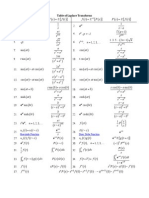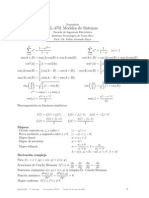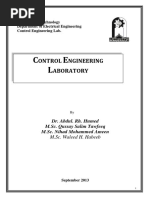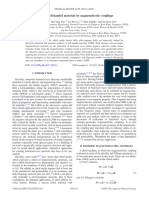Advanced Process Control - Z-Transform Tables For Digital Control
Uploaded by
delm44Advanced Process Control - Z-Transform Tables For Digital Control
Uploaded by
delm44566
DYNAMIC RESPONSE OF DISCRETE-TIME SYSTEMS
Table 24.1
z-Transforms (At = Sampling Period)
Time Function f(t)
Laplace
Transform F(s)
1
s
unit step
Set),
z-transform
F(z)
r1
1-
I:::.tr1
(1 - r1f
(n -
I)!
lim -1 n-I __
sn
a~O
aan-1
an-1
1
s +
ab
1
e-bl)
+ -a -
Set)
b b
(s
e-al
1
b e-al sin
a)(s
b)
a)(s
b ~ a
bt
C-
b
(a - b) (1 - e-aMz-l)
!1t e -aMz-I
(1 - e-acl1r1f
1
(s + a)2 + b2
1-
2r1e-acll
1b2
sin bl:::.t
r1e-acll
1-
cas b!1t
rle-a~1
2rle-acll
e-2acllr2
cas b!1t
cas b!1t
e-2aMr2
unit impulse
INVERSION
e~b~lrl)
a]
1
+ a)2
s + a
+ a)2 +
1-
b)
(s
- kAt)
e-al cas bt
24.2
e-acl1z-1
e~aMrl
2.
1__ 1_ +
ab Ll - rl
e-bl)
(s
f(t
e-aMz-1
1
1-
1
s(s +
__a -a_b
S(t),
1-
b _ a (e-al
-
F(z)rk
F(s)e-kMS
OF z-TRANSFORMS
Once a z-transform has been obtained (by whatever means), we need to be able
to obtain the values of its corresponding
time-domain
function at the sampling
instants. This is analogous to inverting Laplace transforms back to the time domain.
The inversion of a z-transform F(z) to its corresponding time domain functionf(t)
is not unique because the inverse z-transform does not yield a continuous time
function. Instead the values of the function are obtained only at the sampling
instants. We know that a variety of continuous signals can be reconstructed
from
f*(t); that is, aliasing prevents the unique identification of the continuous function
of time. On the other hand, the transformation
from F(z) to f*(t) (or, equivalently,
from F(z) to f(nllt)) is unique. Consequently,
we define the inverse z-transform
operator, denoted by Z-1, as follows:
f*(t)
= {f(nllt)}
= Z-l[F(z)]
The inverse z-transform consists of the sampled
nth sampling instant as f(n/1t).
To illustrate the inversion process, consider
(24-45)
values f*(t),
F(z)
represented
= rl/(l - P1r1).
at the
If F(z)
You might also like
- 1 Unit Impulse 1 2 Unit Step 1: TABLE 2-1 Laplace Transform PairsNo ratings yet1 Unit Impulse 1 2 Unit Step 1: TABLE 2-1 Laplace Transform Pairs3 pages
- Notes On Hypergeometric Functions: 1 Definitions and NotationsNo ratings yetNotes On Hypergeometric Functions: 1 Definitions and Notations4 pages
- Tutorial - Math.lamar - Edu PDF Laplace TableNo ratings yetTutorial - Math.lamar - Edu PDF Laplace Table2 pages
- Lecture 7: Input-Output Models Shift OperatorsNo ratings yetLecture 7: Input-Output Models Shift Operators6 pages
- 1. Unit sample δ (n) 1 δ (n-k) z 2. Unit step u (n) z/ (z-1) 3. Exponential a u (n) z/ (z-a) 4. Sinusoidal sin (θ n) u (n) θ n) u (n)No ratings yet1. Unit sample δ (n) 1 δ (n-k) z 2. Unit step u (n) z/ (z-1) 3. Exponential a u (n) z/ (z-a) 4. Sinusoidal sin (θ n) u (n) θ n) u (n)5 pages
- Computer Controlled Systems 3 Astrom Wittenmark Solution ManNo ratings yetComputer Controlled Systems 3 Astrom Wittenmark Solution Man116 pages
- Analysis and Design of Linear Control Systems, 06thNo ratings yetAnalysis and Design of Linear Control Systems, 06th6 pages
- Feedback and Control System(Updated 0214)No ratings yetFeedback and Control System(Updated 0214)33 pages
- Solution Manual Digital Control and State Variable Methods75% (16)Solution Manual Digital Control and State Variable Methods128 pages
- Student Solutions Manual to Accompany Economic Dynamics in Discrete Time, secondeditionFrom EverandStudent Solutions Manual to Accompany Economic Dynamics in Discrete Time, secondedition4.5/5 (2)
- Analytic Geometry: Graphic Solutions Using Matlab LanguageFrom EverandAnalytic Geometry: Graphic Solutions Using Matlab LanguageNo ratings yet
- Inverse Trigonometric Functions (Trigonometry) Mathematics Question BankFrom EverandInverse Trigonometric Functions (Trigonometry) Mathematics Question BankNo ratings yet
- Fundamentals of Electronics 3: Discrete-time Signals and Systems, and Quantized Level SystemsFrom EverandFundamentals of Electronics 3: Discrete-time Signals and Systems, and Quantized Level SystemsNo ratings yet
- SOM6629519 Unit Control System Acceptance Test Procedure100% (2)SOM6629519 Unit Control System Acceptance Test Procedure25 pages
- Indelec - Prevectron Lightning Protection SolutionsNo ratings yetIndelec - Prevectron Lightning Protection Solutions2 pages
- POLOLU A4983/A4988: A Getting Started Guide. - DECRNo ratings yetPOLOLU A4983/A4988: A Getting Started Guide. - DECR5 pages
- HendrixACS - 5. B. 15kV 3 Phase-With Logo CABLE ECOLOGICO0% (1)HendrixACS - 5. B. 15kV 3 Phase-With Logo CABLE ECOLOGICO47 pages
- 03 - 02 - 02 Communication Medium TP1 v01.02.02 ASNo ratings yet03 - 02 - 02 Communication Medium TP1 v01.02.02 AS49 pages
- Electronic Boost Solenoid Installation InstructionsNo ratings yetElectronic Boost Solenoid Installation Instructions5 pages
- Mode-Matching Analysis of H-Plane Ferrite-Loaded Rectangular Waveguide DiscontinuitiesNo ratings yetMode-Matching Analysis of H-Plane Ferrite-Loaded Rectangular Waveguide Discontinuities10 pages
- A Robust Near-Eld Body Area Network Based On Coaxially-Shielded Textile MetamaterialNo ratings yetA Robust Near-Eld Body Area Network Based On Coaxially-Shielded Textile Metamaterial12 pages
- SUP0146 - DSC3000 - On-Sample Transducer CalibrationNo ratings yetSUP0146 - DSC3000 - On-Sample Transducer Calibration7 pages
















































































